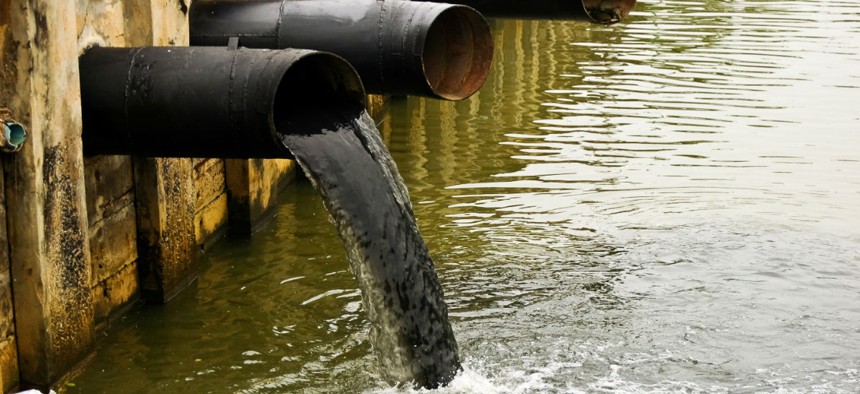
wonderisland / Shutterstock.com
The Obama EPA Has No Intention of Slowing Down
Republicans have launched several attempts to stop the new rules to regulate water pollution in streams, lakes, and rivers.
In finalizing new rule that will give it new authority to regulate pollution in streams, lakes, and rivers, the Environmental Protection Agency has a message for its critics: Bring it on.
Wednesday, EPA and U.S. Army Corps of Engineers announced it was going ahead with one of the Obama administration's more controversial environmental regulation proposals—the so-called Waters of the United States rule. The new rule, using authority to reduce pollution in waterways under the 1972 Clean Water Act, says that federal agencies have regulatory power over streams and wetlands that flow into downstream water sources, which EPA says will ensure that the government can restrict upstream pollutants.
The proposal has drawn aggressive fire from congressional Republicans and industry groups, notably the agriculture industry. The rule, they say, represents a regulatory overstep that would give EPA power over streams, ditches, and other small waterways, potentially opening up routine activities to permit requirements.
The House this month passed two legislative attempts to scale back the rule, one a rider on the energy and water appropriations bill, the other a bill from the Transportation and Infrastructure Committee that would require EPA to withdraw the rule and write a new one.
A bipartisan group of 12 senators introduced a bill in April that would also require EPA to rewrite its regulation, which cosponsor Republican Pat Roberts called "EPA's egregious federal overreach."
But even EPA's outreach has attracted criticism.
A New York Times story charged that EPA used grassroots campaigning to drum up positive comments for its rule and questions have arisen over an EPA-backed hashtag called #DitchTheMyth designed to beat back criticism of the rule. Senate Environment and Public Works Committee Chairman Jim Inhofe has said he'd like to probe the agency's social-media work and Senate Small Business Committee Chairman David Vitter sent a letter Tuesday requesting more information on EPA's work with outside groups on the rule.
"EPA needs to be held accountable and confirm to the American people that it followed all relevant laws during the rule-making process before the WOTUS rule is finalized," the Louisiana Republican wrote.
EPA Administrator Gina McCarthy said she'd "welcome anyone to take a look at what we do," calling the Times story "baffling."
"The agency is doing what we have always done with outreach," McCarthy told reporters Wednesday. "This is our job, and we've done a good job, and there is no way in the world we have crossed a legal line."
"The only people with reason to oppose the rule are polluters who knowingly threaten our clean water," said White House climate adviser Brian Deese.
McCarthy said the listening tour for the rule was extensive and included more than 400 meetings with and direct outreach to several agricultural groups to hear their concerns. Since proposing the rule last year, EPA clarified its definition of tributaries and connections to downstream waterways, McCarthy said, trying to reduce confusion over EPA's plans.
It's a model that's becoming more common as the Obama administration works in its second term to solidify its environmental agenda, especially its climate-change agenda and rules limiting carbon emissions from new and existing power plants. Every environmental regulation is matched by intense industry backlash and a congressional attempt to block it, but the second-term administration has doubled down on its regulations.
The water rule is meant to clarify what waterways are subject to federal oversight under the Clean Water Act, which EPA says was muddled by a pair of Supreme Court decisions that left it unclear how far upstream EPA had the power to control pollution.
According to a blog post from the EPA and Army Corps, the rule summarized more than 1,200 scientific studies to determine which streams and wetlands have a role in impacting pollution in larger lakes and rivers downstream. The rule, for example, is meant to clarify that federal agencies won't regulate features like intermittent waterways or wetlands that don't connect to a larger body of water. The rule also wouldn't affect artificial lakes and ponds, grass swales and depressions from construction, and other activities that cause water to fill and pool.
In response to concern from agriculture groups, the rule will also maintain exclusions for agricultural practices and would not interfere with private-property rights, according to the administration.
Put simply, the rule regulates "features that look like and act like a tributary," said Jo-Ellen Darcy, assistant secretary for the Army for civil works.
McCarthy said an effort was made to write "clear language with clear boundaries" backed by science in response to early criticism about what bodies would be covered.
Environmentalists have backed the rule, saying it will drastically improve clean-water protections and help prevent incidents like a massive pollution breakout in Toledo last year that shut down water for the city for days. A poll released by the League of Conservation Voters this month found that 80 percent of 800 polled voters said they would support the rule, including 70 percent of rural voters.
(Image via wonderisland / Shutterstock.com)






